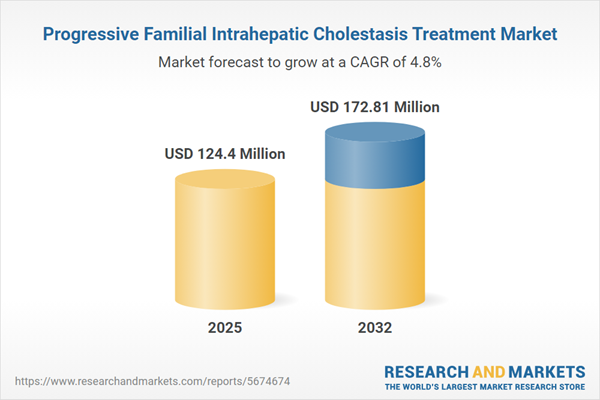Speak directly to the analyst to clarify any post sales queries you may have.
The Progressive Familial Intrahepatic Cholestasis Treatment Market is evolving rapidly, driven by ongoing advancements in precision therapeutics, improved diagnostics, and strategic responses to regulatory changes. Senior decision-makers navigating this market must address complex clinical and operational landscapes while optimizing global access and supply chains.
Market Snapshot: Progressive Familial Intrahepatic Cholestasis Treatment Market
The Progressive Familial Intrahepatic Cholestasis (PFIC) treatment market grew from USD 118.62 million in 2024 to USD 124.40 million in 2025. It is projected to continue expanding at a CAGR of 4.81%, reaching USD 172.81 million by 2032. This robust trajectory reflects increased investments in molecular therapies, the development of novel interventions targeting specific PFIC subtypes, and a steady emphasis on improving patient outcomes across diverse healthcare settings.
Scope & Segmentation
This report delivers a thorough assessment across multi-dimensional segments, technologies, and global regions shaping PFIC care:
- Treatment Types: Pharmacotherapy, Supportive Care, Surgical Interventions
- Pharmacotherapy Approaches: Antibiotics, Bile Acid Sequestrants (Cholestyramine, Colesevelam), IBAT Inhibitors (Maralixibat, Odevixibat), Rifampicin, Ursodeoxycholic Acid
- Supportive Care Strategies: Nutritional Support, Symptom Management
- Surgical Interventions: Biliary Diversion, Liver Transplantation
- Drug Classes: Antibiotics, Bile Acid Sequestrants, IBAT Inhibitors, Ursodeoxycholic Acid
- End Users: Homecare, Hospitals, Specialty Clinics
- Distribution Channels: Hospital Pharmacy, Online Pharmacy, Retail Pharmacy
- Routes of Administration: Intravenous, Oral
- Patient Age Groups: Children, Adolescents, Adults
- PFIC Types: Type I, Type II, Type III
- Regions Covered: Americas (including North America and Latin America), Europe, Middle East & Africa, Asia-Pacific
- Key Companies: Albireo Pharma, Mirum Pharmaceuticals, Teva Pharmaceutical Industries, AbbVie, Glenmark Pharmaceuticals
Key Takeaways for Decision-Makers
- PFIC management is shifting from traditional symptom-based approaches to targeted, precision-driven therapies, integrating pharmacotherapy, supportive care, and surgical advancement.
- The adoption of IBAT inhibitors, refinement of gene therapies, and the evolution of supportive nutrition strategies set the stage for stronger, multifaceted treatment pathways.
- Commercialization strategies must be tailored, with end-user contexts and patient demographic profiles directly influencing therapeutic deployment and delivery model choices.
- Stakeholders are investing in adaptive supply chain models and new sourcing partnerships to mitigate cost changes and ensure timely market access in light of trade policy shifts.
- Pediatric populations and region-specific regulatory challenges require differentiated research and engagement strategies for sustainable growth.
Tariff Impact on the PFIC Therapy Market
Recent US tariffs on pharmaceutical raw materials and technology components have introduced fresh obstacles to cost containment for emerging PFIC therapies. These policy changes prompt companies to reevaluate sourcing and manufacturing strategies, seeking alternative suppliers, investing in in-house capabilities, and pursuing new risk-sharing alliances. Enhanced collaboration with contract manufacturers and regulatory agencies is also fostering streamlined production and delivery processes. These adaptive measures are essential to safeguard supply continuity and maintain pricing stability in a dynamic global environment.
Methodology & Data Sources
This report is grounded in a multi-method approach, combining in-depth interviews with key opinion leaders, proprietary trial and prescription databases, regulatory filings, and literature reviews. Quantitative data from pharmaceutical sales, healthcare infrastructure indices, and scenario modeling underpin the analysis, with insights validated via expert panels to ensure clinical and regulatory alignment.
Why This Report Matters
- Enables strategic alignment across R&D, regulatory affairs, and commercial operations to capture opportunity in PFIC treatment solutions.
- Provides granular insights into patient, product, and geographic segments, supporting customized go-to-market and investment strategies.
- Equips leaders to proactively navigate policy changes, tariff headwinds, and emerging therapeutic innovations within the rare disease ecosystem.
Conclusion
The PFIC treatment market is experiencing a paradigm shift, propelled by molecular innovation, collaborative strategies, and evolving regulatory frameworks. Executive teams leveraging these insights can drive market leadership and improve patient outcomes in this complex and dynamic field.
Additional Product Information:
- Purchase of this report includes 1 year online access with quarterly updates.
- This report can be updated on request. Please contact our Customer Experience team using the Ask a Question widget on our website.
Table of Contents
3. Executive Summary
4. Market Overview
7. Cumulative Impact of Artificial Intelligence 2025
Companies Mentioned
The companies profiled in this Progressive Familial Intrahepatic Cholestasis Treatment market report include:- Albireo Pharma, Inc.
- Mirum Pharmaceuticals, Inc.
- Teva Pharmaceutical Industries Ltd.
- AbbVie, Inc.
- Glenmark Pharmaceuticals Limited
Table Information
| Report Attribute | Details |
|---|---|
| No. of Pages | 196 |
| Published | November 2025 |
| Forecast Period | 2025 - 2032 |
| Estimated Market Value ( USD | $ 124.4 Million |
| Forecasted Market Value ( USD | $ 172.81 Million |
| Compound Annual Growth Rate | 4.8% |
| Regions Covered | Global |
| No. of Companies Mentioned | 5 |









